Island-hopping in the Cyclades in 2 weeks
Cyclades. Probably the most archetypal Greek islands. If you’ve never been to the Greek islands, this is where you should start. Santorini and Mykonos may be the most famous in this group of 24 inhabited islands (as well as the ones easiest to get to, at least from abroad), but it would be a shame to overlook the lesser known ones. Island-hopping is an easy and fun way to explore the Greek islands and this is exactly what I decided to do two years ago, when I first visited Cyclades (it is also what I have been doing every summer since then).
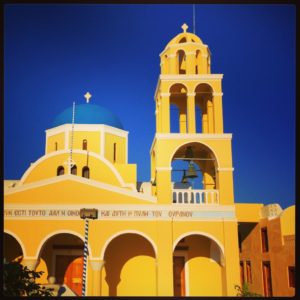
The 13-day itinerary I describe here is slightly different to the one I followed, and it is the one I would have followed had I had the insight that I now have. Start in Santorini, and then take the ferry to Amorgos. From there, continue to Koufonisia and finally to Mykonos. I would recommend spending at least three nights on each island. You could start on a Monday, which takes you through to Saturday of the following week. Alternatively, you could start on a Sunday and this will take you through to Friday. Either way you could combine your island-hopping holiday with a couple of nights in Athens before and after.
For me, the best time to visit the Greek islands is July or August, as this is when the ferries are at their most frequent, the weather at its warmest and the atmosphere at its best.
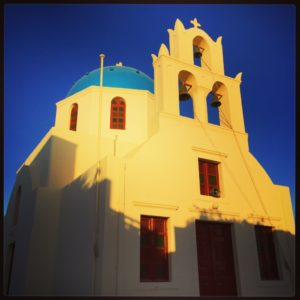
Day 1 (Monday) – Santorini
In the summer, there are plenty of direct flights to Santorini from Europe (as well as from mainland Greece). There are also daily ferries from Athens; the fastest ones take about five to five and a half hours and arrive midday (SeaJets, approx. 60-70 euros; Hellenic Seaways, approx. 60 euros).
To kick your holiday off the beaten track and avoid the crowds, rent a car and drive to Pyrgos Kallistis (or simply Pyrgos), a village built amphitheatrically at the highest point of the southernmost island of the Cyclades. You know what comes next: panoramic views of the whole island (not just the caldera). This is simply the perfect place to watch the sunset that Santorini (or Thira as is also known as) is worldwide famous for.
Afterwards, stroll through the narrow, labyrinthine streets, and then experience the Greek hospitality and local cuisine at Penelope’s Ouzeri, a small traditional eatery, or at Brusco ‘wine. coffee. deli’. Try the ntomatokeftedes (tomato balls/fritters), the locally-produced cheese (hlorotyri) and homemade desserts. Then, go to the SantoWines Winery (another good place to watch the sunset from) and try the island’s wine. Santorini and Vinsanto are both made from the indigenous grape Assyrtiko; the latter is a sweet dessert wine.
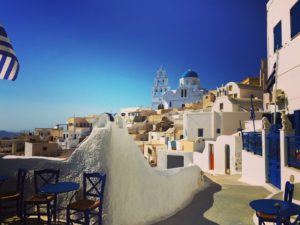
Day 2 (Tuesday) – Santorini
Start at the southwest coast of the island. Here you will find the archaeological site of Akrotiri, an ancient Minoan city that had been buried beneath volcanic ash from 1,650 B.C. up until 1967. It is estimated that the settlement was constructed around 4,500 B.C. Get there early to avoid the crowds.
From Akrotiri Beach, you can take a caique to Aspri (White) and Mavri (Black) Beach, or you can walk to Kokkini (Red) Beach and swim against the backdrop of red cliffs.
Then have lunch (fresh seafood of course) at Spilia tou Nikola (The Cave of Nikolas), a seaside fish tavern within walking distance from Akrotiri. Try the locally-produced fava (yellow split-peas) and white eggplants – delicious appetizers not normally found elsewhere in Greece.
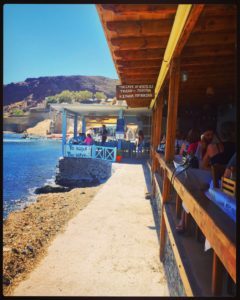
In the evening, make your way to Oia, one of the two main settlements on the west coast of the island (Fira is the other one). Built on a steep slope of the caldera, this charming hilltop village is worldwide famous for its sunsets and can often be overcrowded with tourists. Wander around the narrow streets and admire the blue-domed churches before you stop at Atlantis Books, a bookstore that is now considered among the must-visit places in Oia. Panagia of Platsani, Saint George and Panagia Agion Panton are among the most beautiful churches and also worth a visit. Sun Spirit is a good place to sit down, enjoy a cocktail and watch the iconic sunset.
Day 3 (Wednesday) – Santorini
Wake up early and stroll around Oia first thing in the morning, as this is when it tends to be at its quietest.
Go swimming in Vlyhada, a beach on the south coast of the island, where you can also have lunch at one of the waterside taverns around the picturesque harbor. Then have a cocktail at Theros Wave Bar, an all-day beach bar.
In the evening, go to Fira, another hilltop village on the west coast of the island. Escape the crowds and walk along the caldera-edge pathway towards the villages of Firostefani (15-minute walk from Fira) and Imerovigli (half an hour walk from Fira). Watch the sunset at the small church of Agios Georgios, or at Volkan On The Rock, a café-bar that serves coffee, as well as excellent food and cocktails (the menu is by Ergon Greek Deli & Cuisine). You can even watch a movie there, at the open-air cinema.
Another open-air cinema is Kamari, situated in the village of the same name, on the east coast of the island. Watching a movie under a sky full of stars is one of my favorite things to do in Greece in the summer, and I would highly recommend you try it.
Finally, have dinner at Metaxi Mas, a restaurant at the inland village Exo Gonia, that many consider the best one on the island. It may not be on the cliff edge, but it still offers panoramic views.
After dinner, go back to Fira, to the Kira Thira Jazz Bar.
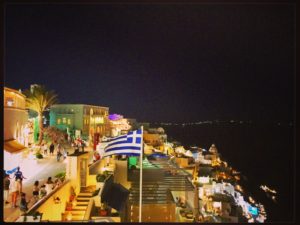
Day 4 (Thursday) – Santorini – Amorgos
Continue your island-hopping adventure, and take the ferry to Amorgos; the journey is an hour on Mondays, Wednesdays, Thursdays and Saturdays (SeaJets, approx. 50 euros), but considerably longer on Tuesdays, Fridays and Sundays. Amorgos is neither as famous nor as crowded as Santorini, but is popular with the French, since it featured in Luc Besson’s film ‘Le Grand Bleu’ (‘The Big Blue’).
The main port of the island is Katapola. Here you can rent a car, but before you drive away, have a meal at one of the several seaside taverns at either side of the little port: Capetan Dimos on the side where the ferries arrive, or Almyriki and Vitsentzos on the opposite side. Try some seafood dishes (it couldn’t get any fresher) or the local specialty patatato (goat with potatoes) along with some Amorgean white wine. Afterward, enjoy a refreshing cinnamon-based drink at Moonbar (very close to Almyriki and Vitsentzos).

As well as its local produce and cuisine, and its role in the French cult-classic, Amorgos is also renowned for its hiking trails, which not only connect the island’s villages and settlements, but also provide access to ecclesiastical and natural landmarks, and several archaeological sites (Minoa, Arkesini and Vigla), which you could visit over the following days.
One of these trails, Fotodotis, connects Katapola with Hora, the capital and one of the main settlements of the island. This ascending path is rather short and easy, so if your accommodation is at Katapola (like mine was), why not walk to Hora? Start your ascend not long before sunset, so you can watch the sun diving into the deep blue waters of the Aegean.
In Hora, you will be welcomed with a palette of colours: blushing bougainvillaeas climb the walls of white-washed houses and blue-domed churches and chapels, with their doors and window shutters painted blue, red or green, matching the chairs and tables scattered around the cobblestone alleys.
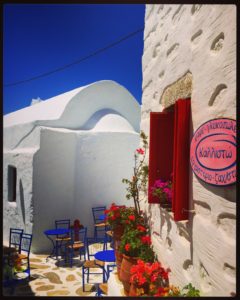
Day 5 (Friday) – Amorgos
Start your day with a coffee at Kallisto, a little café-patisserie in Hora, which you will undoubtedly visit again. The reason? Their fragrant and moist portokalopita (orange pie) indulgently served with vanilla ice-cream.
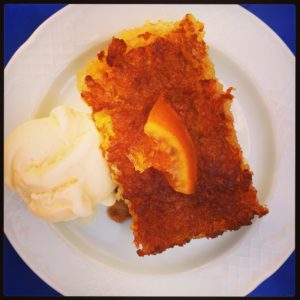
Walk past the windmills at the edge of Hora towards the landmark of Amorgos, the Greek-Orthodox monastery of Panagia Hozoviotissa. Built by Byzantine emperor Alexius Comnenus I in the 11th century, this whitewashed monastery is wedged into a cliff face 300 metres above the sea. Climb the nearly 300 steps, walk through the low marble doorway and take the staircase that leads to the chapel where treasures and icons are kept. You will be rewarded with a vertiginous yet panoramic view of the Mediterranean, complimentary rose-flavoured loukoumi (Greek Turkish delight) and psimeni raki (raki with honey and spices) offered by the monks. From there, descend towards the pebble beach of Agia Anna. Here the waves splash against a rock, which a chapel of the same name is built on. It’s then time to dive into the deep blue Aegean.
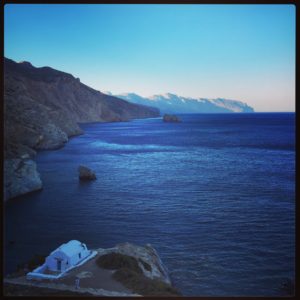
In the afternoon, drive south to Kalotaritissa. On your way there, you will catch glimpse of the rusty shipwreck ‘Inland’ now known as ‘Olympia’, which has been lying at the small bay of Livero for the last 40 years. Continue towards Kalotaritissa; a rainbow of fishing boats anchored in the small bay will soon appear. A little café on the semi-organised sandy beach serves tyropita (cheese pie) and mpougatsa (filo pastry with custard). Hop on the boat taxi, which will take you to the uninhabited islet of Gramvousa. Walk past the small chapel, and you will find yourself in a secluded beach.
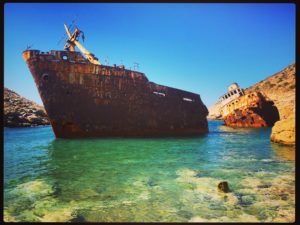
Spend your evening in Hora. Have a meal at Tranzistoraki (try their pancetta with fig marmalade), followed by a cocktail at next-door Botilia, or another slice of portokalopita at Kallisto!
Day 6 (Saturday) – Amorgos
Drive north to Aegiali. A wonderful drive along a winding road will bring you to this small village, where you can embark on one of the most scenic and beautiful hiking trails on the island. Walk past the small church of Agia Barbara towards Agios Theologos. Dedicated to John the Evangelist and built on the site of an ancient temple, this beautiful Byzantine monastery dates back to the 7th century. Continue on the precariously narrow path towards the beautiful chapel of Stavros, situated above an old bauxite mine. The trail ends up at the summit of mount Krikelos, the highest point of Amorgos. The view is compensation: from here you can see the whole island and the endless Aegean Sea.
On your way back, follow the stone-paved path towards Panagia Epanohoriani. Before you, the old church stands tall; behind you lies the islet of Nikouria. Stop at the charming old-fashioned mountain village Tholaria, to savour a Greek coffee at Kali Kardia, an old-style café-ouzo-mezedopolio (place that serves coffee, ouzo and mezedes). Try their meatballs.
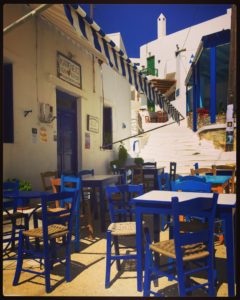
Continue to Aegiali beach. There you will find DISCOtheQUE (simply Q for the locals), an all-day beach bar where teenagers sip iced coffees, which will later turn to beers and cocktails, as the day turns to night.
Day 7 (Sunday) – Amorgos – Koufonisia
On your last day in Amorgos, why not follow Jacques’ and Enzo’s example and go diving? There are two diving centres: Amorgos Diving Center in Aegiali, and We Shall Sea in Katapola.
Alternatively, go swimming in Maltezi. You can reach this secluded beach either by boat taxi from Katapola, or on foot.
In the afternoon (or evening, if there is not an afternoon service on the day of your travel), take the ferry to Koufonisia (‘Hollow Islands’). Located between Amorgos and Naxos, this is a group of three islands: Ano (or Pano) Koufonisi (‘Upper Hollow Island’), Kato Koufonisi (‘Lower Hollow Island’) and Keros. Interestingly, when Greeks say ‘Koufonisia’, they usually refer to Ano Koufonisi, perhaps because it is the only one of the three which is inhabited. The journey from Amorgos to Ano Koufonisi usually takes less than an hour; yet, this tiny island is considered remote and, cliché as it may sound, a hidden gem, off the beaten track or undiscovered paradise, even for Greeks and Italians, who are the main visitors (SeaJets, 14 euros; Hellenic Seaways, 22 euros; Blue Star Ferries, 6.50 euros; no afternoon or evening service on Fridays).
Hora is the island’s only village and spreads out behind the ferry quay. Wander along the main street towards the small harbor of Loutro. Have dinner at the seaside tavern Karnagio, where the octopuses hang to dry before they are grilled over charcoal. Or, at Capetan Nikolas, another waterside tavern. Then, have a cocktail (or perhaps even a shot of rakomelo) at the bar Scholio. Take a look at the interior of the bar, to admire photographs taken by the owners.
Day 8 (Monday) – Koufonisia
Today’s the day for beach-hopping. Start walking anti-clockwise towards the beach of Pori; even though the distance from Hora to Pori is only 3.5 km, beach-hopping is more of a day-long activity.
First stop is Finikas, where a beach bar may tempt you to stay. Inviting as this may be, continue towards Fanos and Platia Pounta. The latter, also known as Italida, is a nudist beach; however, many prefer not to bare it all and still enjoy its golden sand and azure waters. From there, walk along the cliff path towards Pori; you will pass by the small caves, one of the most famous sights of the island. Piscina (‘Pool’), or Devil’s Eye, is the one that attracts the biggest crowd – diving from the top of the cave into the naturally formed pool.
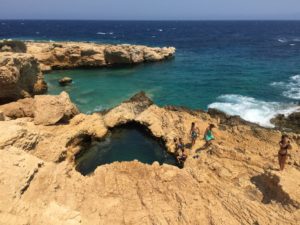
At Pori, have lunch at the cozy restaurant Kalofeggo, before you continue to the secluded by the caves ‘beach’ Gala. This is slightly tricky to find, as you can only see it once you are actually there. In the evening, join a ‘yoga by the beach’ session (10 euros).
Afterwards, take the inland road, or hop on a boat taxi, back to Hora. Be prepared to queue for Souvlaki sti Strofi; this is a small corner eatery famous for its delicious souvlaki (grilled meat on a skewer served inside pitta bread). The seating area is limited, but souvlaki is best enjoyed as take-away anyway. If you’d rather have a sit-down meal, try the elegant restaurant Gastronautis.
After dinner, have a cocktail and dance the night away at the bar Sorokos. Overlooking the harbor, it is a popular choice among the young visitors, comfortably sat on colorful cushions at the cliff edge. Mylos (‘Windmill’) is another bar offering a panoramic view of the harbor.
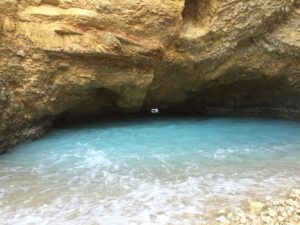
Day 9 (Tuesday) – Koufonisia
Take the boat taxi to Kato Koufonisi and spend the day there. Get off at Nero, one of the few beaches on this uninhabited island. Have lunch at the tavern Venetsanos, before you take the boat back to Ano Koufonisi.
Koufonisia Classical Music Festival takes place in July and August; this summer there are six concerts approximately one week apart (most of them fall on Wednesdays though). The festival features both Greek and international artists.
Day 10 (Wednesday) – Koufonisia – Mykonos
Begin your day by having breakfast at Kalamia, an all-day café-bar. In the afternoon, take the high-speed ferry to Mykonos; the journey takes one and a half hour (services run on Mondays, Wednesdays, Thursdays and Saturdays only; SeaJets, 55.80 euros). You will arrive at the New Port, north of Hora (the main town on the island). Hire a car to make your life much easier.
I have to admit that I thought Mykonos as little more than a party island destination and a celebrity-magnet. However, the first time I set foot on this cosmopolitan island, Hora simply took me by surprise. I remember wandering around the narrow, labyrinthine alleyways, taking pictures of cats napping, or of the blushing bougainvillaeas climbing up the walls of the whitewashed houses, churches and chapels. Even though I am not religious, I was mesmerized by the Church of Panagia Paraportiani and the Life Giving Spring Orthodox Metropolitan Church.
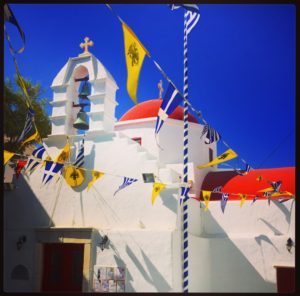
Past the expensive boutiques, jewelry shops and galleries, make your way to the waterfront of Little Venice, a great place to watch the sunset. Bao’s, Negrita, Semeli and Galleraki are all charming bars, where you can enjoy fantastic cocktails and views of the sunset, the windmills and the 18th-century fishing houses with their balconies overhanging the water. The picturesque Goumeniou Square is a must-go place for dinner. I’ve had dinner at Familia, and at the nearby Lucky Fish, both times followed by ice cream at Kayak.
Day 11 (Thursday) – Mykonos
There are a number of beaches on the island, but the most famous ones (where the celebrities hang out and the beach parties take place) are on the south-west coast. Having a car and a more-than-average budget to spend will both come handy. Psarou, Paraga, Paradise and Super Paradise are the best-known and most expensive ones and they are all organized. Sunbeds may cost a small fortune, but the combination of crystalline waters, signature summer cocktails and luxurious atmosphere is compensation. Psarou is home to the renowned restaurant Nammos, whereas Super Paradise is home to JackieO’ Beach Club and Restaurant. Enjoy the dazzling turquoise waters, then join the party and dance till late.
The parties continue in Hora, where there are a number of gay-friendly bars and clubs, such as the waterfront JackieO’ Town Bar and Babylon, overlooking the Old Port, as well as Porta, off a narrow alleyway.
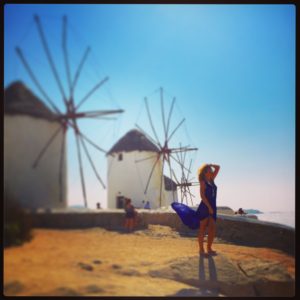
Day 12 (Friday) – Mykonos
Go on a guided tour to the nearby, uninhabited island of Delos. The boat journey takes only half an hour. Delos is located two kilometres west of Mykonos; yet, it feels like you’re going a thousand miles away from the buzz of Mykonos. The mythical birthplace of Apollo and Artemis, Delos is now a UNESCO World Heritage Site and one of the most important historical and archaeological sites in Greece.
Later in the evening, you could watch a movie at the open-air cinema Manto in Hora.
Day 13 (Saturday) – Mykonos
Spend as much of your last day of your island-hopping holiday in Hora. Start with a coffee at Passo Doble, an all-day café-bar; then wander towards the windmills. Have lunch (preferably souvlaki or gyros) at Sakis Grill House. Perhaps, have another coffee (or even an afternoon cocktail) in Little Venice, before you wave goodbye to the Cyclades. If you’re as lucky as I was, you will come across the famous pelican of the island.
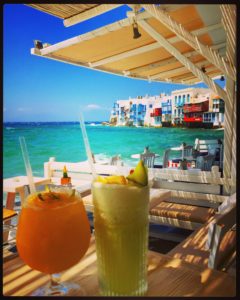
In the summer, there are plenty of direct flights from Mykonos to Europe (as well as to mainland Greece). Alternatively, there are ferries to Athens; the fastest takes almost 3 hours (SeaJets, approx. 60 euros).
How to get there
Check out the ferries timetable here. The Eurail Greek Islands Pass is worth considering.
Accommodation
Santorini
Accommodation in Santorini can be quite expensive. If your budget allows it, why not choose one of the 59 hotels with an infinity pool on the edge of the caldera. These are located on the west coast of the island (Oia, Fira, Imerovigli, Firostefani). Even if you cannot afford to stay in one of these luxurious hotels, I would strongly recommend you stay on the west coast.
Amorgos
Aegialis Hotel & Spa is the only five-star hotel on the island; it is located near the village and port of Aegiali on the northwest coast. If you follow my itinerary, however, it might be better to stay in Katapola or in Hora.
Koufonisia
Ever wished to sleep in an actual windmill? If yes, Windmill Villa is the place where you should stay. To avoid disappointment, book early, as there is only one apartment available to rent. It has to be rented for a minimum of three days and can sleep up to four people. Located very close to Hora, it is probably as unique an accommodation as you can get.
Mykonos
Mykonos is undoubtedly an expensive island to visit, and accommodation is no exception. If you can afford to treat yourself to a luxurious hotel, why not choose one of the 120 hotels with an infinity pool; these are scattered all over the island, but the majority are either on the west coast (where Hora and the New Port are) or on the south coast (where the beach parties are). Otherwise, stay as close to Hora as your budget allows.
Further reading (on the Greek islands and beyond)
To better prepare for my trip, I used the Lonely Planet Greek Islands Travel Guide
For more tips about the Greek islands, read the Guardian readers’ travel tips.
If you’d like a book to read whilst on holiday, check out my post ‘Crime & Fjords: 9 Scandinavian writers you should read’.
To follow my travels around the world, simply subscribe to the Traveling Psychiatrist (just click on the menu on the left hand side).
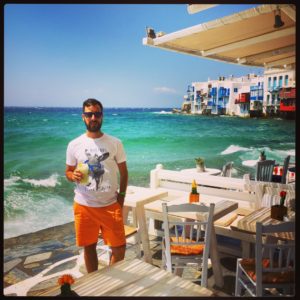
‘Happy is the man, I thought, who, before dying, has the good fortune to sail the Aegean Sea.’
Nikos Kazantzakis, Greek writer
Have a great journey!
Alex
(the Traveling Psychiatrist)
3 Comments
Greg
mate your site is really cool, but it has a poor Domain Authority
sad truth is that sites with poor Domain Authority won’t rank high in Google and in result get very little of traffic
I had the same problem in the past and my website didn’t rank high in Google
I searched for a professional who would help me with it; found one guy who really helped me rank higher in Google and increase my Domain Authority to 58! I’m super happy with this score
Contact him: http://janzac.com/contact-janzac/ (his prices are very reasonable for the service he provides)
admin
Thank you Greg. I’ll have a look at it.
Pingback: